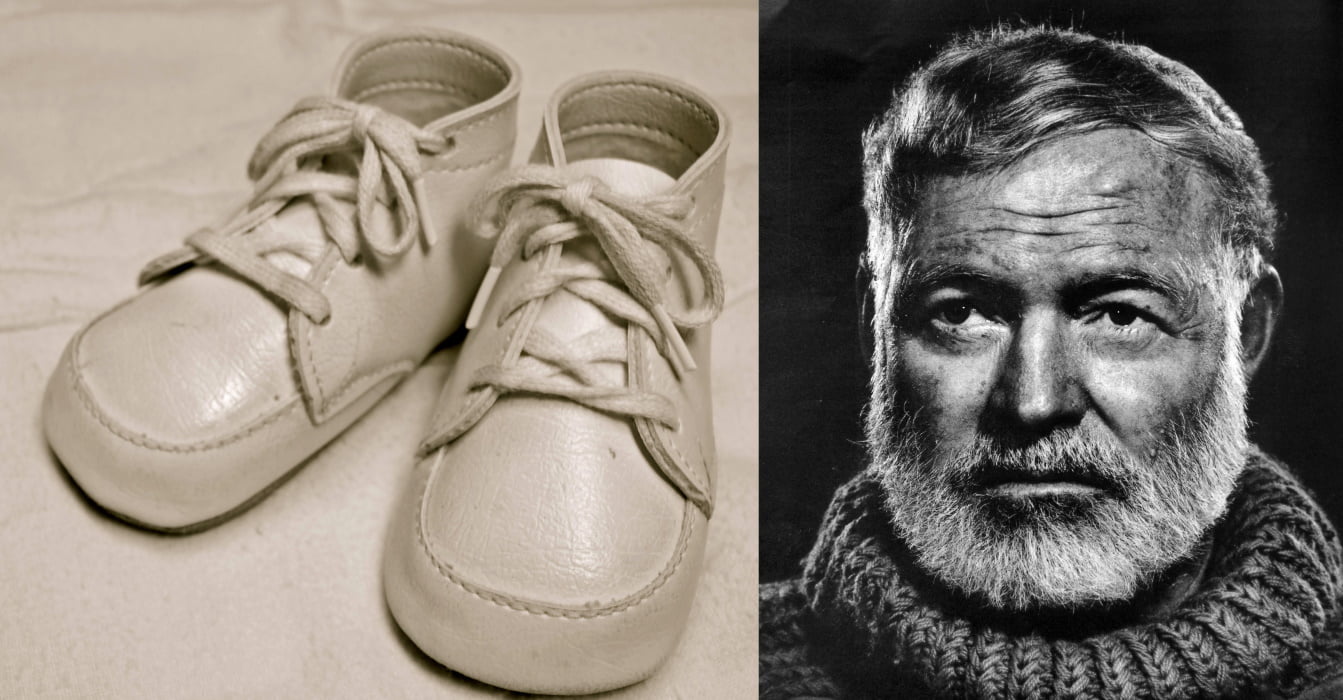The story of how a Nobel laureate in literature wrote the shortest story that can touch anyone has been circulating on social networks for many years in the form of text and graphic memes. We checked whether Hemingway actually wrote such a story.
In its canonical form in Russian, the story goes like this:
“Ernest Hemingway once bet that he could write the shortest story that could touch anyone. He won the argument: “Children’s shoes for sale. Unworn.”
English-language sources usually also mention the specific length of the story according to the bet - six words (“For sale: baby shoes, never worn”). In the West, this text is so popular that it led to the emergence of a website http://www.sixwordstories.net/ with similar works. In Russia, it gave rise to a series of memes beginning with the phrase “Ernest Hemingway once bet that he could write the shortest story that could touch anyone...” and ending with the author’s photograph or screenshot.
In the collected works of Hemingway, as well as in individual editions of the American’s works, such a story or any information about him is absent. But similar advertisements can be found in American periodicals of the early 20th century. For example, “A baby stroller is for sale. Never Used" in a 1906 newspaper. And in 1910, a newspaper in Spokane, Washington, published an article entitled “The Tragedy of the Death of an Infant Revealed During a Clothes Sale.” The unnamed author noted:
“The world is an interweaving of joy and sadness, a continuous play of comedy and tragedy. And even in everyday life there are small details in which touching stories are woven. Last Saturday an advertisement appeared in the local newspaper: "For sale, handmade baby clothes and crib. Never used." <…> Perhaps this means little to the average reader. But for a mother who has devoted many days to planning the life of her unborn child, this is a huge grief and disappointment.”

Most likely, it was the cited article that contributed to the transition of this small everyday story to the literary plane. Because just seven years later, in 1917, William Kane wrote an essay on “powerful short stories.” Among other things, it described a hypothetical story entitled “Little Shoes. Unworn" about a woman who lost her child. The idea was picked up by others—in 1921, the story appeared as an example of “poignant dramaturgy” in Life and the Boston Globe.
As we can see, by the time Ernest Hemingway just began to engage in writing, the story about the shoes was already known in literary circles. And for the first time the authorship of this work is attributed to Hemingway in the biographical play by playwright John De Groot "Daddy", published in 1984. The play premiered three years later and did not gain much popularity. But it is there that an episode appears in which Ham declares that he can write a perfect six-word story on a dare. De Groot later claimed that the play was "based on events described by Ernest Hemingway or those who knew him well. Whether this actually happened or not, we will never know."
At the same time, in 1988, a book by Cuban Norberto Fuentes, Ernest Hemingway Rediscovered, was published in the United States, in which he shared hitherto unknown facts from the life of the great writer. In particular, there is this episode:
“One morning Hemingway walked into the New York branch of Scribner’s and bet that he could write “the shortest story in the world.” A complete story with a plot of just six words. He was willing to write it on a piece of paper, and if Scribner and others present agreed that the story worked, then each would pay him $6."
“We read the story and had to fork over the cash,” Scribner recalled. — This story brought him $60. The untitled story looked like this: “For sale, baby shoes, never worn.”

This story became truly widely known in connection with Hemingway in 1991, when the incident was included in Peter Miller's book “Publish and Promote! Secrets of selling a manuscript from a literary agent." The author claimed that in 1974 the story was told to him by a “very respectable newspaper magnate.” Moreover, in Miller's version, Hemingway argued not with the publishing house employees, but with his colleagues in the restaurant. The story was soon retold by the famous writer Arthur Clarke, and in his version the bet was not $6, but $10. Well, in 2006, Miller, in his new book, moved the scene of the dispute from a restaurant to a hotel.
In 2014, the scientific journal Bulletin of Popular Culture published an article by Frederick Wright, “Small Prose Got Even Smaller: Hemingway, Statement of Fact, and a Four-Word Urban Legend.” The author came to the conclusion that the whole story was made up, since there was very little evidence.
Thus, in the case of the story about Hemingway and the shortest story, we are most likely dealing with a tale that arose in the 70s, after the death of the writer. Variations of the story appeared at the beginning of the 20th century, and all the evidence of his connection with Hemingway surfaced incredibly late and differed too much in detail.
Fake
Read on topic:
1. https://quoteinvestigator.com/2013/01/28/baby-shoes/
4. https://www.snopes.com/fact-check/hemingway-baby-shoes/
5. https://archive.org/details/ernesthemingwayr0000fuen_l3r4/
6. https://mybook.ru/author/garson-otul/oni-etogo-ne-govorili-izrecheniya-znamenitostej-pr/
If you find a spelling or grammatical error, please let us know by highlighting the error text and clicking Ctrl+Enter.







